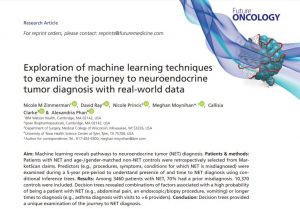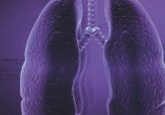Exploration of machine learning techniques to examine the journey to neuroendocrine tumor diagnosis with real-world data

In this research article, published in our partner journal Future Oncology, authors affiliated with IBM Watson Health (MA USA), Ipsen Biopharmaceuticals (MA USA), Medical College of Wisconsin (WI USA) and University of Texas Health Science Center at Tyler (TX USA) used machine learning algorithms of regression analysis and conditional inference trees to explore patient pathways to neuroendocrine tumor (NET) diagnosis using real-world data (RWD). The study included 3,460 patients with NET and 10,370 controls, with 70% of patients with NET having a commonly misdiagnosed condition prior to diagnosis. Results from this study support existing literature that suggests patients with NET experience a complicated path to diagnosis. The authors concluded that this study demonstrates the potential for future research using automated statistical methodology to be clinically impactful.
Abstract
Aim: Machine learning reveals pathways to NET diagnosis.
Patients & methods: Patients with NET and age-/gender-matched non-NET controls were retrospectively selected from MarketScan claims. Predictors (e.g., procedures, symptoms, conditions for which NET is misdiagnosed) were examined during a 5-year pre-period to understand presence of and time to NET diagnosis using conditional inference trees.
Results: Among 3,460 patients with NET, 70% had a prior misdiagnosis. 10,370 controls were included. Decision trees revealed combinations of factors associated with a high probability of being a patient with NET (e.g., abdominal pain, an endoscopic/biopsy procedure, vomiting) or longer times to diagnosis (e.g., asthma diagnosis with visits to >6 providers).
Conclusions: Decision trees provided a unique examination of the journey to NET diagnosis.
Lay Abstract
We present the novel analytic approach of machine learning using RWD to describe patient pathways to NET diagnosis. Due to the rarity and presentation of the disease, NET diagnosis is commonly inaccurate and delayed. We aimed to demonstrate the potential of analytics using conditional inference trees. Decision trees revealed specific combinations of characteristics associated with a high probability of being a patient with NET (e.g., abdominal pain, an endoscopic/biopsy procedure, vomiting) or longer times to diagnosis (e.g., asthma diagnosis with visits to >6 providers). Results from this study support prior literature and add advanced analyses that take initial steps toward developing tools aimed to help clinicians with early and accurate NET diagnosis. The methodology can be improved upon and translated to other diseases.






